neilpcraven
Well-Known Member
Hi all,
Below you will find an account of my first solo AG brew day. Based on what you see/read, feel free to give me any tips and feedback - I'm new to this sort of thing.
I'm from Perthshire in Scotland but these days I call Porto Alegre, in Brazil, home. It's currently hot as hell here - more or less 40 Centigrade (102F) -which added some extra challenges, some of which I'll mention later. Also, as a Brit born during the conversion to metric, I will unapologetically switch between metric and imperial.
I had planned to show some of the frozen corn juice drinkers down here what real beer tastes like. To that end I was going to brew the AG 80/- variant of the Caramelised Scottish Ale recipe from Brewing Classic Styles book. Sadly I didn't have any dark roasted barley to hand as an adjunct (some thing are hard to get down here) so I thought I'd throw in some special B instead, to give it some toastiness, fruitiness and some colour. I read a bit later that this much Special B might be overkill, though. Given that I could only find Belgian Pale malt as well, it seems I've made some sort of bastardised 80/- Dubbel. We'll see what it ends up like.
Before we begin: Safety first!
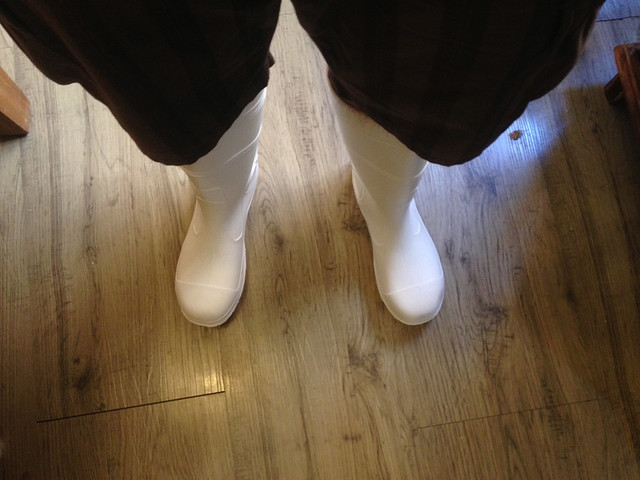
So the recipe turned out like this; just two grains:
5kg (11lbs) Pale ale malt
.25kg (just over 1/2 lb) Special B
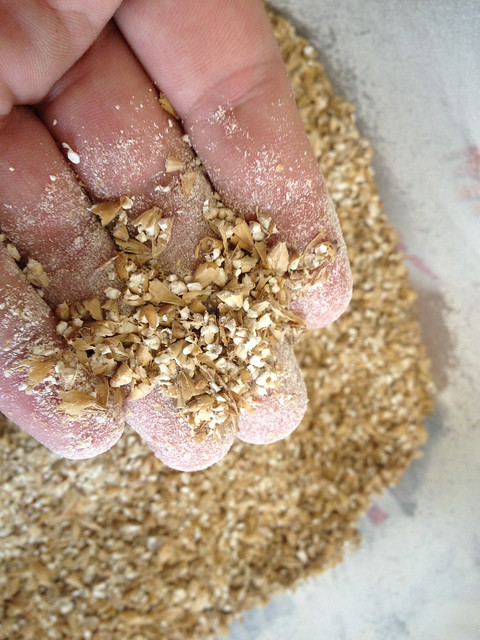
This was the first time using my mill - it seems that things went ok.
I was using the stove top, so heating the strike water wasn't exactly quick:
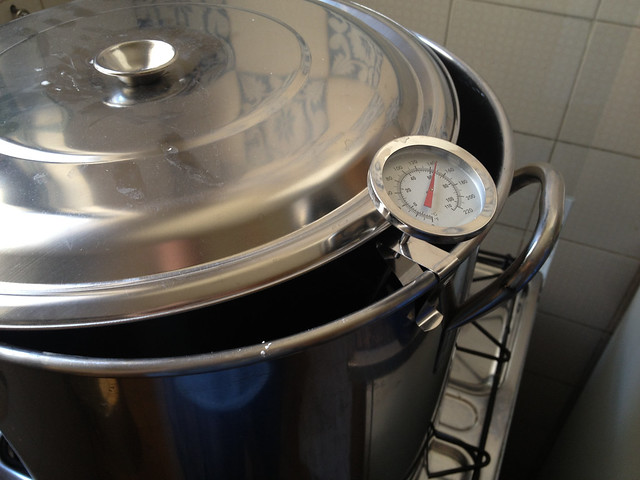
Mixing water with grains isn't so exciting but here's a picture:
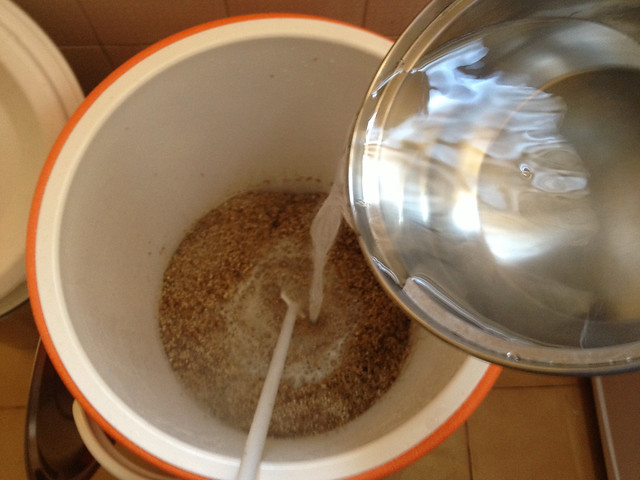
Didn't do anything too controversial here - added the water gradually and stirred it to avoid any big dough balls. I do like this cooler mash tun though! Strike water ended up a little bit cool at 65C so I chucked in a bit more nearly boiling water that brought it up to just under 70C. 20L of water went into the tun. I had to use bottled water since the tap water here, although nice and soft, tastes a bit funky when it gets warm (a sort of algae flavour...). I put few grammes of gypsum and table salt in to balance it out.
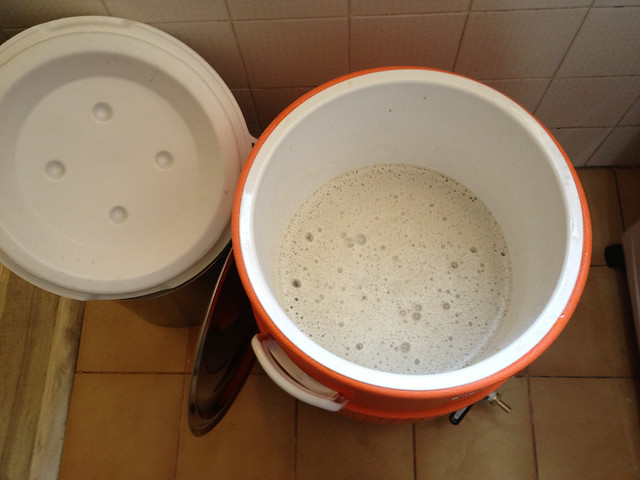
At this point, I stopped for a break because the in 40C heat I was rapidly losing fluids.
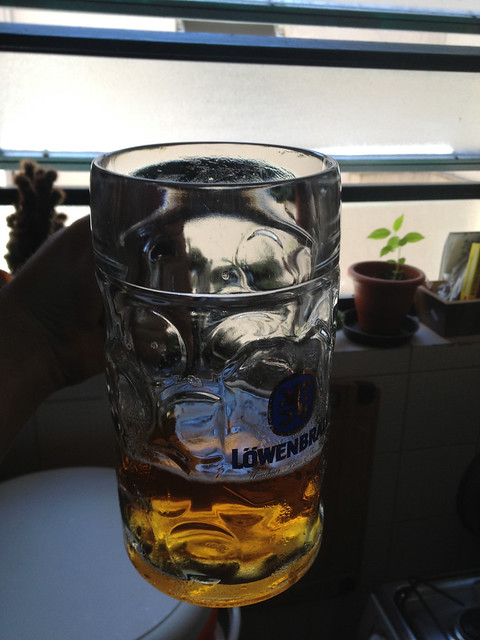
After a typical hour of mashing, I transferred to the kettle. I was being careful here about aeration - is there a consensus about whether hot-side aeration is bad or not? I thought better safe than sorry.
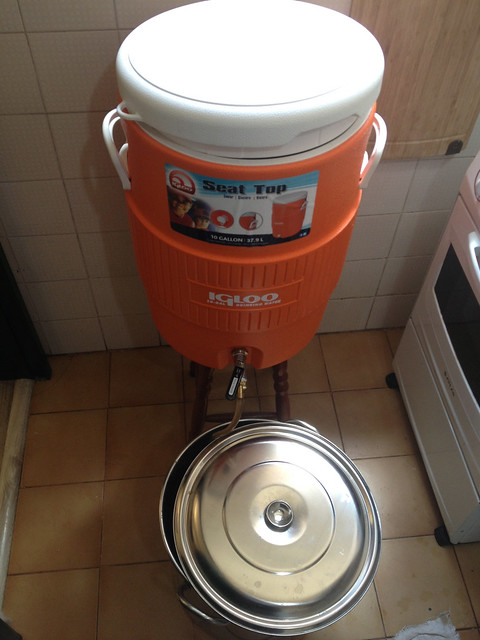
There's a bit more crud in there than I would have liked - need to get better at this Vorlaufing thing:
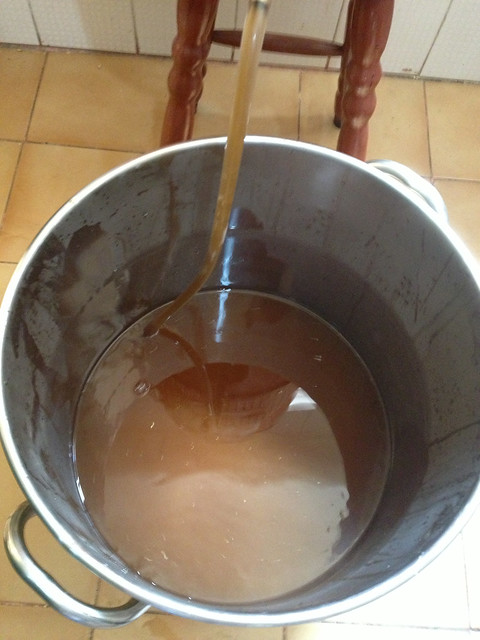
and be more delicate when pouring it back in:
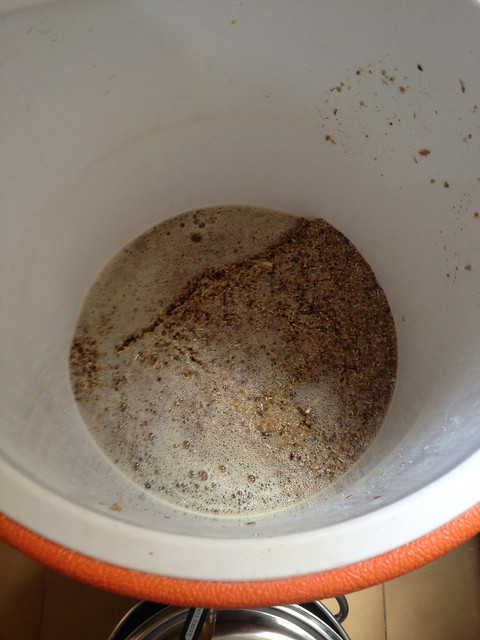
No pics of the batch sparging. I used 13 litres and left it to soak for 15 mins. It looked like it was going to stick for a little while, so I closed the tap a little and patience proved its worth; soon it came running smoothly.
In the book it suggests caramelising the first gallon of wort - I didn't quite have a gallon pot so I had to reserve some in a jug and slowly add it to the smaller pot as space allowed. The kettle's a bit fuller than I would have liked - I ended up with nearly 29l in total! Probably don't need so much strike water next time - at least the recipe called for boiling nearly a gallon of it off, on top of the regular evaporation during a long boil
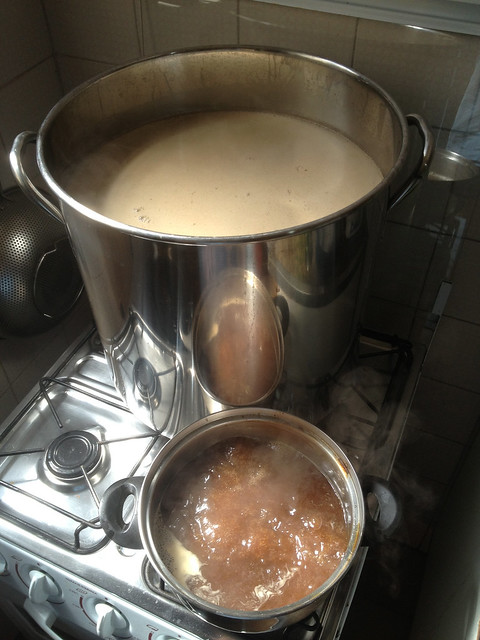
I said it was a solo brew day but I had two willing helpers:

The hops are in, half way through a long 120 minute boil. It wasn't such a vigorous boil, being on the hob, but it was boiling. At least it meant less risk of boiling over!
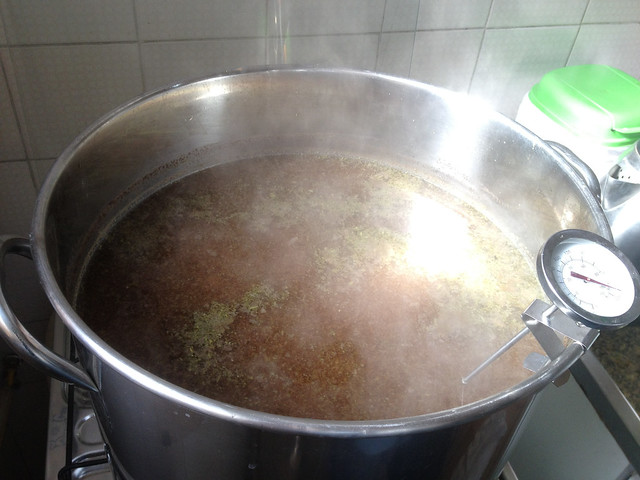
Hop Schedule:
28g (1oz) UK Goldings 60min
5g (1/6 oz) Fuggles 60min
3.5g (1/8 oz) UK Goldings 20 min
The safety boots proved worthwhile as I had to move the kettle from the kitchen to the back room for cooling - the tap in the kitchen didn't fit the attachment for the cooler! Also, since it was so warm here (the cold water was coming out the tap at 35C and it was 40C ambient) it took a while to bring the wort down to sensible temperatures. Hope it didn't allow any nasties to take hold!
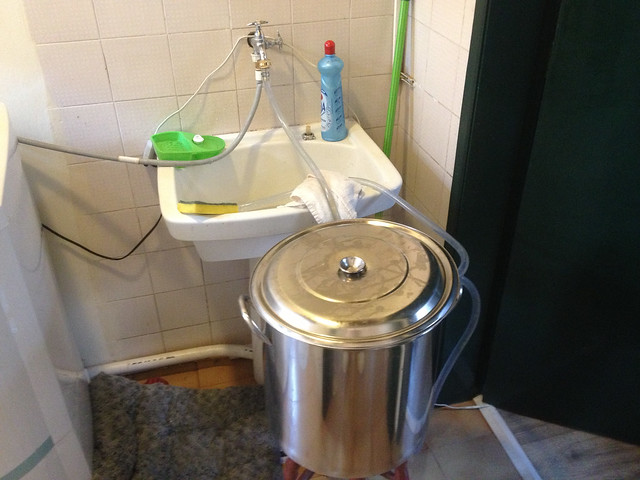
(The dog's bed made a handy sponge to soak up the water leaking out of the tap - the washer disappeared somewhere so there were a lot of drips. I made sure none got in the kettle.)..
Finally it goes into the fermenting vessel, but it's still too warm to pitch the yeast.
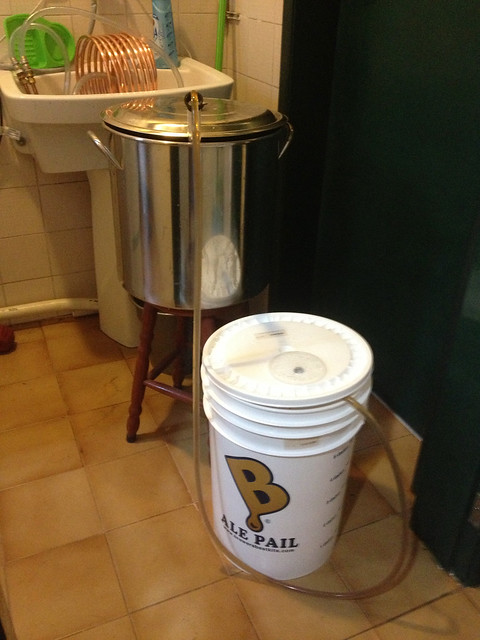
The hose is just poking into the bucket to allow free-fall of the wort, to get a bit of O2 absorbed. I also shook the hell out of it later for more oxygen, but in this heat It's a case of just doing what you can. I had put a sanitised tub lid over the grommet hole in the bucket lid, to stop any nasties getting in.
Later, after a couple of hours 'in ze cooler', I fed it to a rehydrated packet of Safale 04.
The stuff that went into the fermentor had about the right colour for an 80/- and an SG of about 1.054, (a bit strong, but I guess that's because of the long boil.)
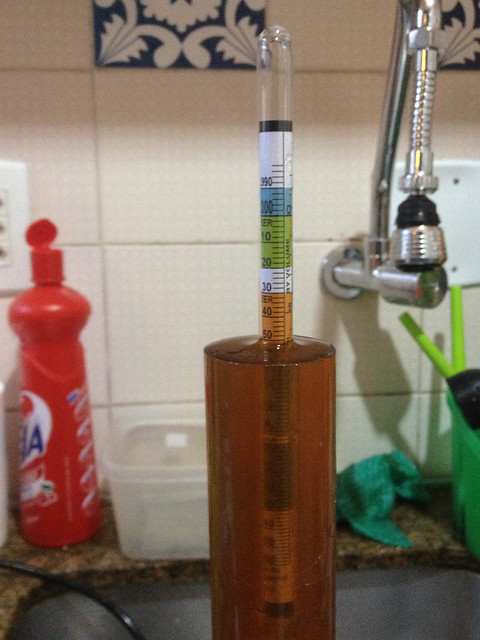
(it reads lower because it was quite warm)
Thought I should compare the Hydrometer to the Refractometer just to be sure (both are new toys!)
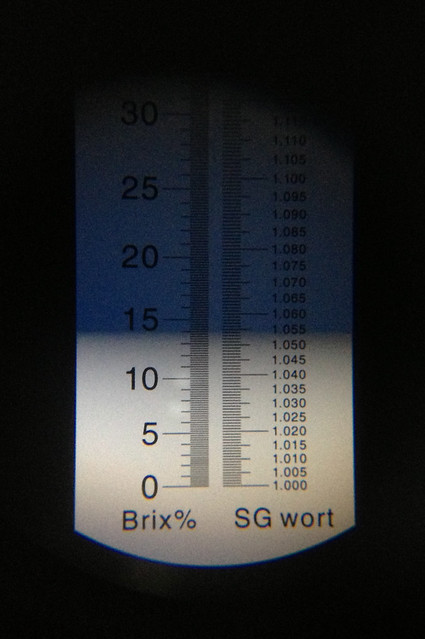
And finally my little helpers helped me put it to bed, with the thermostat set to 15.3C (I heard Safale 04 likes it cool, and I'm sure it's warmer in the bucket).
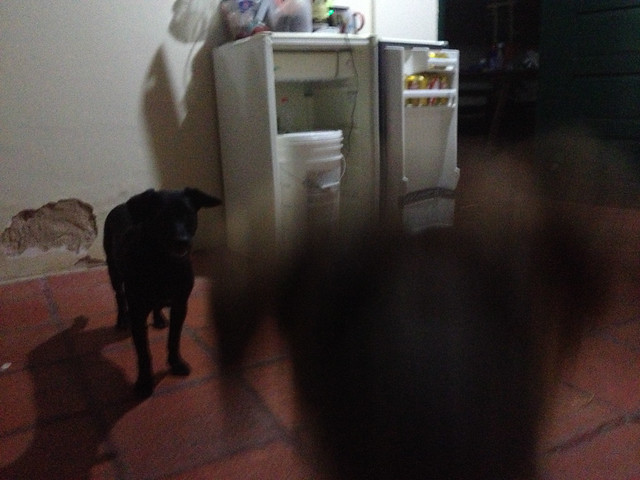
You may (but I hope you don't) recognise the cans of Brahma 0.0 non alcoholic crap in the fridge door. They are there for when my other half's dad comes over (drive here with anything above zero blood alcohol and you're in for trouble) and to remind the beer what will happen if it's a naughty boy. The door to the fridge has been taped up to remind me to resist temptation and poke at it while it's sleeping.
Thanks for reading to the end! I will update in about six weeks when it's ready for tasting!
Neil
Below you will find an account of my first solo AG brew day. Based on what you see/read, feel free to give me any tips and feedback - I'm new to this sort of thing.
I'm from Perthshire in Scotland but these days I call Porto Alegre, in Brazil, home. It's currently hot as hell here - more or less 40 Centigrade (102F) -which added some extra challenges, some of which I'll mention later. Also, as a Brit born during the conversion to metric, I will unapologetically switch between metric and imperial.
I had planned to show some of the frozen corn juice drinkers down here what real beer tastes like. To that end I was going to brew the AG 80/- variant of the Caramelised Scottish Ale recipe from Brewing Classic Styles book. Sadly I didn't have any dark roasted barley to hand as an adjunct (some thing are hard to get down here) so I thought I'd throw in some special B instead, to give it some toastiness, fruitiness and some colour. I read a bit later that this much Special B might be overkill, though. Given that I could only find Belgian Pale malt as well, it seems I've made some sort of bastardised 80/- Dubbel. We'll see what it ends up like.
Before we begin: Safety first!

So the recipe turned out like this; just two grains:
5kg (11lbs) Pale ale malt
.25kg (just over 1/2 lb) Special B

This was the first time using my mill - it seems that things went ok.
I was using the stove top, so heating the strike water wasn't exactly quick:

Mixing water with grains isn't so exciting but here's a picture:

Didn't do anything too controversial here - added the water gradually and stirred it to avoid any big dough balls. I do like this cooler mash tun though! Strike water ended up a little bit cool at 65C so I chucked in a bit more nearly boiling water that brought it up to just under 70C. 20L of water went into the tun. I had to use bottled water since the tap water here, although nice and soft, tastes a bit funky when it gets warm (a sort of algae flavour...). I put few grammes of gypsum and table salt in to balance it out.

At this point, I stopped for a break because the in 40C heat I was rapidly losing fluids.

After a typical hour of mashing, I transferred to the kettle. I was being careful here about aeration - is there a consensus about whether hot-side aeration is bad or not? I thought better safe than sorry.

There's a bit more crud in there than I would have liked - need to get better at this Vorlaufing thing:

and be more delicate when pouring it back in:

No pics of the batch sparging. I used 13 litres and left it to soak for 15 mins. It looked like it was going to stick for a little while, so I closed the tap a little and patience proved its worth; soon it came running smoothly.
In the book it suggests caramelising the first gallon of wort - I didn't quite have a gallon pot so I had to reserve some in a jug and slowly add it to the smaller pot as space allowed. The kettle's a bit fuller than I would have liked - I ended up with nearly 29l in total! Probably don't need so much strike water next time - at least the recipe called for boiling nearly a gallon of it off, on top of the regular evaporation during a long boil

I said it was a solo brew day but I had two willing helpers:

The hops are in, half way through a long 120 minute boil. It wasn't such a vigorous boil, being on the hob, but it was boiling. At least it meant less risk of boiling over!

Hop Schedule:
28g (1oz) UK Goldings 60min
5g (1/6 oz) Fuggles 60min
3.5g (1/8 oz) UK Goldings 20 min
The safety boots proved worthwhile as I had to move the kettle from the kitchen to the back room for cooling - the tap in the kitchen didn't fit the attachment for the cooler! Also, since it was so warm here (the cold water was coming out the tap at 35C and it was 40C ambient) it took a while to bring the wort down to sensible temperatures. Hope it didn't allow any nasties to take hold!

(The dog's bed made a handy sponge to soak up the water leaking out of the tap - the washer disappeared somewhere so there were a lot of drips. I made sure none got in the kettle.)..
Finally it goes into the fermenting vessel, but it's still too warm to pitch the yeast.

The hose is just poking into the bucket to allow free-fall of the wort, to get a bit of O2 absorbed. I also shook the hell out of it later for more oxygen, but in this heat It's a case of just doing what you can. I had put a sanitised tub lid over the grommet hole in the bucket lid, to stop any nasties getting in.
Later, after a couple of hours 'in ze cooler', I fed it to a rehydrated packet of Safale 04.
The stuff that went into the fermentor had about the right colour for an 80/- and an SG of about 1.054, (a bit strong, but I guess that's because of the long boil.)

(it reads lower because it was quite warm)
Thought I should compare the Hydrometer to the Refractometer just to be sure (both are new toys!)

And finally my little helpers helped me put it to bed, with the thermostat set to 15.3C (I heard Safale 04 likes it cool, and I'm sure it's warmer in the bucket).

You may (but I hope you don't) recognise the cans of Brahma 0.0 non alcoholic crap in the fridge door. They are there for when my other half's dad comes over (drive here with anything above zero blood alcohol and you're in for trouble) and to remind the beer what will happen if it's a naughty boy. The door to the fridge has been taped up to remind me to resist temptation and poke at it while it's sleeping.
Thanks for reading to the end! I will update in about six weeks when it's ready for tasting!
Neil


